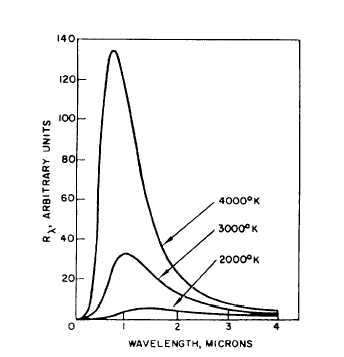The total energy emitted by an object at all
wavelengths is directly dependent upon its
temperature. If the temperature of a body is increased
10 times, the IR radiation emitted by the body is
increased 10,000 times. If the energy emitted by a
black body and its wavelengths is plotted on a graph,
a hill-shaped curve results (fig. 6-4). By looking at
this graph, you can see that the energy emitted by
short wavelengths is low. As the wavelengths get
longer, the amount of energy increases up to a peak
amount. After the peak is reached, the energy emitted
by the body drops off sharply with a further increase
in wavelength.
Infrared Optics
Many of the materials commonly used in visible
light optics are opaque at IR frequencies. For this
reason, they cannot be used in IR imaging systems.
The optical material used in IR imaging systems
should have a majority of the following qualities:
. Be transparent at the wavelengths on which the
system is operating
l Be opaque to other wavelengths
. Have a zero coefficient of thermal expansion to
prevent deformation and stress problems in optical
components
Figure 6-4.-Black body radiation.
. Have high surface hardness to prevent scratch-
ing the optical surfaces
. Have high mechanical strength to allow the use
of thin lenses (high-ratio diameter to thickness)
l Have low volubility with water to prevent
damage to optical components by atmospheric
moisture
. Be compatible with antireflection coatings to
prevent separation of the coating from the optical
component
None of the materials currently used for IR optics
have all of these qualities. However, silicon,
germanium, zinc selenide, and zinc sulfide have many
of them.
Infrared Detectors
The detector is the most important component of
the IR imaging system.
There are many types of
detectors, each having a distinct set of operating
characteristics.
Bolometers, Golay cells, mercury-
doped germanium, lead sulfide, and phototubes are
the most commonly used types of detectors.
Detectors can be characterized by their optical
configuration or by the energy-matter interaction
process. There are two types of optical configura-
tions—elemental and imaging.
ELEMENTAL DETECTORS.— Elemental
detectors average the portion of the image of the
outside scene falling on the detector into a single
signal. To detect the existence of a signal in the field
of view, the detector builds up the picture by
sequentially scanning the scene.
The elemental
detector requires time to develop the image because
the entire scene must be scanned.
IMAGING DETECTORS.— Imaging detectors
yield the image directly. An imaging detector is
considered a myriad of point detectors. Each of the
detectors responds to a discrete point on the image.
Therefore, the imaging detector produces the entire
image instantaneously.
A good example of an
imaging detector is photographic film.
6-4

